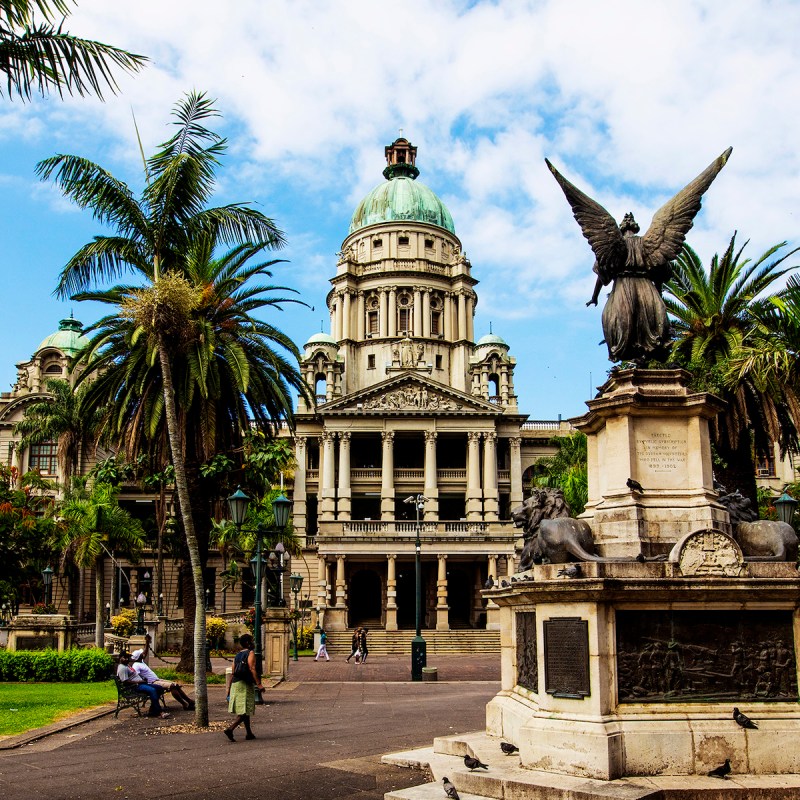
The typical tourist visiting South Africa has an itinerary that looks something like this: Fly into Johannesburg, head to Kruger for a safari, and then head to Cape Town for some wining and dining. While that’s got the makings of a fantastic trip, it does mean most visitors miss out on Durban, the third-largest city in the country. Often overlooked in favor of Cape Town or Johannesburg, Durban is quite possibly South Africa’s best-kept city secret.
Videos by TravelAwaits
Joburg may be trendy and Cape Town may be glamorous, but Durban is cool. Best known for its beaches and Afro-Indian culture, Durban has plenty to see and do. An hour by plane from Johannesburg and 2 hours from Cape Town, Durban is a great place to visit year-round thanks to its fantastic weather. So, if you are planning a trip to South Africa, make sure to add Durban to your itinerary.
Let’s delve a little deeper into Durban and discover some of the best things to see and do.

1. The Golden Mile
Probably the best place to start is the Golden Mile, which takes its name from a series of golden sandy beaches that stretch for 3.7 miles along the edge of the city’s business district. The paved promenade is the perfect place to walk, run, cycle, skateboard, or do a segway tour. The sandy beaches are a massive playground; take a dip in the blue Indian Ocean, stroll along the beach, try your hand at a sandcastle, or relax and work on that tan. This is probably the safest surfing spot in South Africa; hundreds of surfers take to the water here every day and there are shark nets and lifeguards year-round. Even if you’re not a surfer, this is a great place to watch the action.
Too hot for a stroll? Then “take the back seat” in a Zulu rickshaw. A century ago, more than 2,000 of them crowded Durban’s streets and docks. Now, only about 20 registered pullers remain, all wearing beaded headdresses and pulling similarly decorated rides.
The Golden Mile is also home to uShaka Marine World and Moses Mabhida Stadium (more about them below). You can take care of any souvenir shopping at the Amphitheatre Flea Market, held every Sunday at the beachfront.

2. uShaka Marine World
At one end of the Golden Mile is The Point, overlooking the mouth of Durban’s harbor. Once infamous for its gangsters and dockside prostitutes, The Point is now home to high-end condos. The main attraction here is uShaka Marine World — a water park, the largest aquarium in the country, and one of the most popular attractions in Durban. The highlight of a uShaka visit is the Ocean Walk experience, when you get to walk across the bottom of the Open Ocean Exhibit and observe all sorts of marine life, including several species of shark, tons of sardines, and rays. You can actually do more than just watch; uShaka also offers several snorkeling and scuba-diving activities. And if you fancy a bite, book a table at The Cargo Hold and you’ll be dining underwater!

3. Moses Mabhida Stadium
At the other end of the Golden Mile is the city’s sports complex, dominated by the Moses Mabhida Stadium built for the 2010 FIFA World Cup. The stadium is now used for a number of events, including concerts, cricket, football, golf practice, motorsports, and rugby games. If there’s no match on, it’s worth climbing the 500 steps, or riding the Sky Car to the top of the arch that stretches over the field, giving you unrivaled 360-degree views out over the coast and the city. Looking for an adrenaline high? Jump into the void 347 feet above the pitch and swing out in a huge 720-foot arc under the iconic arch; this is the world’s highest rope swing. It’s also the only stadium swing in the world and is even open for children under 18 (as long as they weigh over 90 pounds), should you have an adventurous teenager in tow.

4. Durban Botanic Gardens
The oldest surviving botanical gardens in Africa, founded in 1849, the Durban Botanic Gardens provides a captivating insight into the flora of the region. The property also has some captivating smaller gardens, like the breathtaking Orchid House, the award-winning Sensory Garden, the tea garden, and the herbarium. There’s an impressive collection of living fossil plants — pre-dinosaur cycads — known to have existed for more than 250 million years and now at risk of extinction. The gardens are also home to more than 50 species of resident birds. The gardens regularly host musical concerts, exhibitions, and an indigenous plant fair every September. Entry to the gardens is free and paid guided tours are available.

5. KwaMuhle Museum
The KwaMuhle Museum documents Durban’s urban growth as well as celebrating the efforts of those who fought to end apartheid. It’s a great place to learn more about the history of the city. The museum is housed in the former Native Affairs Department building, an infamous place responsible for enforcing apartheid legislation. Exhibits include photographs, documents, and video testimonials of township life, black migration, the apartheid years, and the contributions made by people responsible for the city’s development. It is one of four museums in Durban that tells the story of the city’s past. The other three are the Old House Museum, the Port Natal Maritime Museum, and the Old Court House Museum.

6. Florida Road
Florida Road used to be an elephant trail to the marsh that is now Durban’s Greyville Racecourse. Known for its well-preserved, 100-year-old Victorian and Edwardian buildings, today, this is one of Durban’s trendiest areas. Lined with cafés, cocktail bars, designer boutique stores, galleries, and eateries, the street comes alive after the sunset with locals and tourists who come to eat, shop, and enjoy Durban’s endless summer. Art lovers can enjoy the African Art Centre, Elizabeth Gordon Gallery, and the Artisan Contemporary Gallery. This is also one of the best places in the city to taste “bunny chow,” a staple Indian-Durban dish made from a loaf of bread that’s hollowed out and filled with curry.
7. Muthi Market
The muthi (traditional Zulu medicine) market in central Durban is an outdoor network of stalls stocked with everything from herbs to animal carcasses. Inyanga (traditional healers) offer lotions, potions, medicines, and other treatments for various ailments. You can purchase “ingredients” like snake skins, crocodile teeth, plants, bird claws, powders, talismans, and more. This tour is definitely not for everyone — the carcasses can be gory and the smells pungent — but it’s an interesting way to learn about Zulu culture and the world of traditional African healing. It’s best to go with a guide, as many vendors are not fluent in English. Street Scene is one tour company that offers visits here.
8. Indian Quarter
Durban has a large Indian community and lots of Indian heritage. It goes without saying that one of the best things to do in Durban is explore its Indian Quarter. Encompassing Victoria Street Market and Juma Masjid Mosque (the largest in the southern hemisphere), Durban’s Indian Quarter is a multicultural mix of sights, sounds, and exotic aromas. Indian, Pakistani, Chinese, and Somali vendors haggle along the narrow pavements, selling spices, saris, incense, intricate handmade jewelry, embroidered fabrics, beaded sandals, and more. Savvy shoppers will get some bargains here and the restaurants boast some of the most authentic Indian cuisine in Durban — make sure to sample the tasty street food.
9. Inanda Township And Heritage Trail
About 20 minutes northwest of Durban is the Inanda Valley, a densely populated semi-rural settlement that played a large role in shaping the history of South Africa. This is where Mahatma Gandhi came up with his passive-resistance philosophy in 1904. It’s also where one of South Africa’s oldest girls’ schools — the Inanda Seminary — was founded by American missionaries in 1869. President of the African National Congress, Dr. John Dube, was born here in 1871 and Nelson Mandela cast his vote here in South Africa’s first democratic elections in 1994. If you are not self-driving, join a tour like the one offered by African Angel.

10. Umhlanga Rocks
Ten miles north of Durban is Umhlanga Rocks (pronounced Umshlanga), a popular, upscale resort town where water sports enthusiasts will find plenty of things to do. Surfing, deep-sea fishing, whale watching, dolphin viewing, scuba diving, and kiteboarding are just some of the activities on offer.
There are long golden beaches and a terrific promenade for runs and walks. The Umhlanga Pier has been called one of the most beautiful in the world, with “whale bones” forming a ribcage over the walkway, colorful mosaics, grates where you can watch the water underfoot, and a lovely viewing platform at the end. One of the nicest sights in the area, particularly at sunset, is the lighthouse, which you can spot on a walk along the beach or from the terrace at the Oyster Box Hotel — one of South Africa’s best spots for a sundowner. The Oyster Box is also renowned for its curry buffet, where you can choose from at least 11 curries, including the traditional Durban lamb curry and red-hot beef vindaloo, as well as naans and homemade chutneys.
Thanks to safety nets, shark attacks at Durban’s beaches are rare. The KwaZulu-Natal Sharks Board maintains the nets that protect the city’s beaches and, while you are in Umhlanga, it’s possible to book an early morning boat ride with the crew that maintains them. It’s rare to see a shark around the nets, but for those that really want a Jaws moment in their lives, there are public shark dissections at the Board’s visitor center.
Pro Tip: A useful resource for your Durban travels is to download the Durban Walking Tour – South Africa’s Melting Pot audio tour guide. It allows you to play and pause as you wish and provides a day or two of entertainment for less than $5. The guide includes maps and directions, as well as insider tips and photos. It’s like having an expert guide in your pocket, who’s available 24/7 on your schedule!

